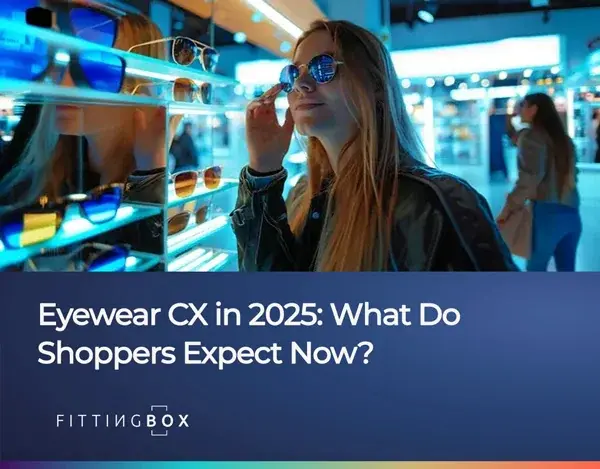.webp)
How Virtual Try-On Boosts Eyewear Sales: A Data-Driven Look
Virtual try-on technology is transforming the eyewear industry by helping customers try on frames digitally before making a purchase. Retailers, both online and in-store, are seeing significant benefits in conversion rates, customer confidence, and reduced returns.
With recent data showing steady growth in adoption, understanding the measurable impact of virtual try-on can help optical businesses make informed strategic decisions. This article takes a data-driven approach to explore how virtual try-on influences sales performance, customer behavior, and overall business outcomes in the eyewear market.

🔑 Key Takeaways
-
Virtual try-on boosts eyewear sales, with studies showing up to 18% higher conversion rates for retailers using it.
-
Cart abandonment drops by 22% for online eyewear stores that offer virtual fitting tools to customers.
-
Returns decrease by up to 28% as shoppers gain more confidence in their purchase decisions with accurate frame previews.
-
Multi-channel integration increases engagement, with 25% more interaction when try-on is available online and in-store.
-
Accurate PD measurement and 3D alignment are critical to ensuring customer satisfaction and trust.
Introduction to Virtual Try-On and Its Market Relevance
The eyewear market has shifted dramatically in recent years, driven by the need for a more seamless and engaging customer experience. Virtual try-on allows shoppers to see how frames look on their face in real time, whether they are browsing online or in-store. According to a 2024 Statista report, over 35% of global eyewear retailers have implemented some form of virtual try-on solution, with adoption expected to grow by another 20% in the next two years.
For optical retailers, this technology is not just a trend but a strategic tool. It bridges the gap between online and physical experiences, increases shopper confidence, and supports the decision-making process. As more consumers expect personalization and convenience, virtual try-on is becoming a standard in competitive eyewear markets.
Measuring the Impact of Virtual Try-On on Eyewear Sales
Virtual try-on solutions have a measurable effect on eyewear sales performance. Data from a 2024 McKinsey study shows that retailers implementing virtual try-on experience an average sales conversion lift of 18% compared to those without it. This is driven by a more confident purchasing process, as customers can visualize frames more accurately.
In e-commerce, where hesitation often leads to abandoned carts, virtual try-on reduces decision friction. A 2025 Shopify Insights report indicates that online eyewear stores using virtual fitting tool see a 22% decrease in cart abandonment. In physical stores, interactive displays enhance engagement and create an innovative shopping experience, leading to higher basket sizes.
The combination of increased conversion and reduced hesitation makes virtual try-on a powerful revenue driver, whether integrated on websites, mobile apps, or in-store kiosks.
Why Virtual Try-On Improves Conversion and Reduces Returns
One of the key reasons virtual try-on impacts sales is its ability to boost customer confidence. By allowing shoppers to see frames on their own face, the risk of dissatisfaction decreases significantly. According to a 2024 Deloitte survey, eyewear retailers that use virtual fitting report up to a 28% reduction in product returns.
Beyond reducing returns, virtual try-on helps convert hesitant buyers. When customers can visualize how a frame looks from different angles, they are more likely to proceed with the purchase. The enhanced experience also reduces the perceived risk of buying eyewear online, which has traditionally been a barrier for many shoppers.
In addition, a smoother buying process strengthens brand trust. Whether the try-on happens on a website or in-store device, customers associate the convenience and accuracy with a retailer that values their satisfaction.
Key Factors for Maximizing Virtual Try-On Impact
While virtual try-on delivers clear benefits, its effectiveness depends on how it is implemented. Accuracy plays a crucial role. A precise pupillary distance measuremen and well-calibrated 3D frame alignment ensure customers see a realistic fit. Poor accuracy can lead to dissatisfaction and undermine trust in the tool.
Integration across channels is equally important. Retailers that offer try-on capabilities on their website, mobile app, and in-store devices capture more engagement and create a consistent customer journey. A 2025 Retail Tech Review study revealed that multi-channel virtual try-on solutions increased customer interaction by 25% compared to single-channel setups.
User experience also matters. Fast loading times, intuitive navigation, and a broad selection of frames enhance adoption. The smoother the virtual fitting experience, the higher the likelihood of conversion and repeat visits.

Real-World Examples and Best Practices
Several eyewear retailers have demonstrated the measurable success of virtual try-on. For example, a 2024 case study revealed that an international optical chain increased its online conversion rate by 20% within six months of integrating a high-accuracy virtual fitting tool. This boost was accompanied by a 15% drop in returns, directly impacting profitability.
Independent optical stores also benefit from virtual try-on. By embedding the technology into their websites, smaller retailers compete more effectively with major e-commerce platforms. Customer engagement increases when shoppers can try on multiple frames instantly and share their choices on social media.
Best practices for maximizing results include offering a diverse selection of frame styles, ensuring compatibility with various devices, and providing clear guidance on how to use the virtual fitting feature. These strategies increase adoption and encourage customers to finalize their purchase with confidence.
Conclusion
Virtual try-on has proven to be a transformative tool for the eyewear industry, combining higher conversion rates with reduced product returns. By enhancing customer confidence and providing a personalized shopping experience, it addresses key challenges faced by both online and physical retailers. Data from recent years shows a consistent pattern: retailers that adopt virtual fitting solutions outperform those that do not.
Looking ahead, as the technology continues to evolve, its integration will become even more essential for maintaining competitiveness. Optical businesses that leverage virtual try-on strategically can expect stronger customer loyalty, improved sales performance, and a more engaging shopping journey.
LET'S TALK
Request a demo, a quote or set up an appointment with one of our sales representatives.
CONTACT USUseful Links
Corporate
© FITTINGBOX 2025 • Terms of use • Privacy & Legal



